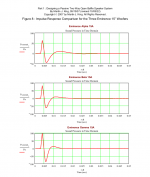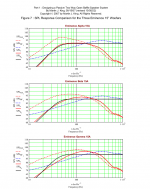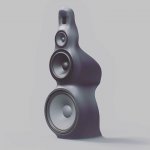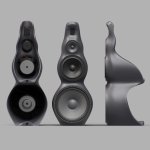Above 0.7 A speaker driver that is well suited to free-air or infinite baffle application.
It's all a stereotype, for OB you can use speakers with qts 0.25 with a cone mass of 120-150 grams and the bass will be better than in speakers with qts 0.7.
Why are speakers traditionally used for OB with qts 0.7 and higher? Because the bass there is achieved due to the strong fluttering of the cone with a weak BL, so it dangles back and forth near the resonant frequency, creating bass. And in speakers with qts 0.25, a powerful magnet controls the cone’s movement strongly near the resonant frequency, so less bass is obtained. But you can get bass if you take a PRO 15-18" speaker with mms 120-150 and with qts 0.25.
Well, I don't digress, but the general description is what it is. That is why as a designer, you are in charge and must make a lot of decisions. The only way forward is to build and test the hypothesis. Some don't mind a sloppy and muddy bass while others can't stand it.
Last edited:
mms is nothing to do with OB .....pleaseIt's all a stereotype, for OB you can use speakers with qts 0.25 with a cone mass of 120-150 grams and the bass will be better than in speakers with qts 0.7.
Why are speakers traditionally used for OB with qts 0.7 and higher? Because the bass there is achieved due to the strong fluttering of the cone with a weak BL, so it dangles back and forth near the resonant frequency, creating bass. And in speakers with qts 0.25, a powerful magnet controls the cone’s movement strongly near the resonant frequency, so less bass is obtained. But you can get bass if you take a PRO 15-18" speaker with mms 120-150 and with qts 0.25.
Btw, what would be the frequency range used for that 12" in cardioid or OB, Oneminde ? 200 hz to 800 hz ? Active low boost ? Sorry if OT, just curiosity...
No no, we are talking full and deep bass. This is not a toy or gimmick. I would use it like a standard subwoofer, 20-150Hz, aka, design it that way.Btw, what would be the frequency range used for that 12" in cardioid or OB, Oneminde ? 200 hz to 800 hz ? Active low boost ? Sorry if OT, just curiosity...
I am still learning about it, but the main points are.
1. Cabinet size is a fraction compared to std sealed.
2. Lowers the Fs by 10-15Hz...
3. No loss of fine details, is crisp and fast.
4. Produces a natural cardiod pattern with reduced room interaction explored by Linwtiz, see W-frame
5. etc.
I am providing a few links which you can use to your advantage.
2. https://www.modalakustik.de/english-1/the-musikbass/the-ripol-principle/ .. they have some useful info on their webpage.
... and remember, have fun 🙂
Sure...
Really think at reading others you should go for a 18" for the OB low end and eventually a 12" for above from 100 to 200 hz till 600 to 800 hz. This is also the diameter that rules the first null in the highs of the driver....this is why you see often 4 ways with OBs... Of course Dsp for lunkwitz teansform and make easier a smooth climbing power respinse DI.
Cool project 🙂
Really think at reading others you should go for a 18" for the OB low end and eventually a 12" for above from 100 to 200 hz till 600 to 800 hz. This is also the diameter that rules the first null in the highs of the driver....this is why you see often 4 ways with OBs... Of course Dsp for lunkwitz teansform and make easier a smooth climbing power respinse DI.
Cool project 🙂
Oneminde, perhaps you know it already, but just in case this link : http://www.dipolplus.de/thema11.php
Also the reading of the OB gallery was full of learning for me. Btw there is a guy that provivided in it an OB design pdf with 3 x 15', the upper one being coax. It is an 3 x 15", Constant directivity design....
Edit Of course a 12" cardioid variovented should work but seems very tricky to do well when you read the thread of the guy behing the Dutch&Dutch C8....
Also the reading of the OB gallery was full of learning for me. Btw there is a guy that provivided in it an OB design pdf with 3 x 15', the upper one being coax. It is an 3 x 15", Constant directivity design....
Edit Of course a 12" cardioid variovented should work but seems very tricky to do well when you read the thread of the guy behing the Dutch&Dutch C8....
Thanks, will check it out.Oneminde, perhaps you know it already, but just in case this link : http://www.dipolplus.de/thema11.php
Edit Of course a 12" cardioid variovented should work but seems very tricky to do well when you read the thread of the guy behind the Dutch&Dutch C8....
Measurements of the C8 show huge suck-outs at multiple places and you can't really mix RiPole and Aperiodic since the RiPole is dependant on equal acoustic output to generate the null.
- To anyone reading who does not know what Variovent or Aperiodic is.
The Variovent is a term or product by Scan-Speak and belong to Aperiodic class of loudspeakers.
Aperiodic woofer systems – The aperiodic loudspeaker is a closed box system that contains a vent stuffed with damping material. The stuffing, usually foam or fiberglass, provides a pressure release for the system at low frequencies. The term aperiodic literally means an absence of resonances at any specific frequency or multiple thereof. Aperiodic damping is defined as “damping of such a high degree that the damped system, after disturbances, comes to rest without oscillation or hunting” (Turner 1988). In a standard acoustic suspension system, the trapped air in the box is quite reactive, or springy, at very low frequencies. The reactive nature of the air will cause excessive cone excursion at system resonance. Adding an aperiodic vent to the system releases internal pressure at resonances, resulting in better control of the cone motion at very low frequencies. The aperiodic offers some of the performance advantages of the transmission line in terms of excellent woofer control and a reduction in internal pressure at frequencies near system resonance, but with enclosures much more manageable in size. It is important to note that no sound emerges from an aperiodic vent, so this design does not resemble a vented loudspeaker in any way. The first patent on such a loudspeaker enclosure was issued in 1936 to Marvel W. Scheldorf, an engineer from RCA; he described his invention as an acoustic resistive device.
Thom Holmes - The Routledge Guide to Music Technology
Audio Concepts Inc. explain their APL: “Performs Like a well-Tuned Transmission Line but with Superior transient Performance and Control”
Further, Audio Physic uses ceramic foam as their acoustic resistance. (This foam is usually used in metal casting to remove slag, so not an audio product per say)
Like I mentioned, I am more drawn to Folded OB than the simpler classic OB since this gives rise to a mechanical means to tune the cut-off frequency, a mechanical crossover if you like, while maintaining OB, Dipole and Aperiodic property's. The benefit of RiPole arrangement is that compared to classical front mounted drivers, we can maintain a narrow baffle which is very important if one desire to reproduce a wide and deep holographic soundstage, something a classic OB have a hard time doing. In loudspeaker design, omnidirectional low frequency's and a large baffle is one of the enemy's of good sound reproduction, I have enough experience with both so I know.
One loudspeaker that produces an amazing phantom soundstage is the original Nautilus and the trick is the lack of baffle, something Danny Richie @ GR Research talks extensively about (a narrow baffle that is), for in the end, isn't the goal of a loudspeaker to gracefully reproduce a recording and get out of the way? .. what is the point if all the loudspeaker does, constantly, is to shout: "LOOK AT ME, I AM RIGHT HERE?".
I have studied and trying to figure out loudspeakers since 2015 with a one goal in mind, to understand them. It started with; "What is a loudspeaker?" and I had no idea how deep the rabbit-hole went for I am still falling. Sure, I have picked up a thing or two along the way, there are no perfect loudspeakers, and every single one is an interpretation and everyone is an "expert" 😉 ... or maybe we are still trying to figure it out, some 100 years in the making huh...
That is the conclusion of some guys in the thread I talked about...best OB are baffle less, and they chose massive Sd and Xmax in the low end. Smooth shape like Nautilus and also the loudspeakers his creator is making today smooths the difraction edges. Easier to make a baffle less than a mold for a Nautilus... and Linkwitz removed more and more the baffle around the drivers but the bass to make it easier to look to I surmise. Some today make direct free standing push pull with two 18" face to face...
You may include Bastanis design in your study. I have a diya buddy who is happy with it. Tge tweeter compression tweeter is open back...so dipole and not compression anymore... 2 x12" as mid, huge 18 half sloated in a M frame. (See also Jazmann member open bass subwoofer he uses with his ESL loudspeaker...made with two 12" from Peereless.
The Nautilus is more or less a 4-way baffle-less tapered tube absorber which does a great job. Laurence Dickie himself can demonstrate.
I don't want to copy, I want to understand such that I be an engineer, and right now, RiPole fits my agenda since it allow me to maintain a narrow baffle, more so than a traditional dipole. This is very important.
The smaller 2-way is produced in England, same place as the birth of Nautilus.I like what he is producing in South Africa 😉
saw this creation on Facebook a while back, designed by Odin Robinson. It can't be called OB Nautilus since the Nautilus shape isn't present, but clearly inspired by, plus, its a take on the Folded technique. Wonderful design.
Attachments
Its not easy being a loudspeaker designer and it likely take years to understand what to look for and in part to chose what to give up...
You don't need ebp or any other similar nonsense telling you what you should do with a drive unit. Simulate frequency response of any combination, investigate what will the room do to the response and decide which solution you are willing to give a chance of building and evaluating.
Not completely true, that EBP isn't useful, it is when it comes to sealed and ported variants, but for OB no. Also, at some point you yourself had no idea which parameters mattered, you read and tested your way forward. At one point in time, we were all toddlers who learned to walk .. 😉
mms is nothing to do with OB .....please
Mass matters, if small, then the bass will not be enough.Because it is impossible for an open speaker to create bass, it does not have a box that forms bass, so it must create bass on its own due to a heavy cone.
Here's an example of the same speaker (beyma 12mwnd, 59 mms) playing in OB:
and box:
and in the latter case, the bass is full-bodied and other instruments too
filled and in the first case only light outlines of sounds.So for OB speaker with such a mass is not sufficient.
And here everything is fine with the bass:
Used speakers for bass and midbass :
Acoustic Elegance IB15AU( 152 mms)
Acoustic Elegance Dipole15 (90 mms). Check out how it sounds at 25.16.
And here the Russian used four beyma sm115k ( qts 0.25, 121 mms) + 18 "in OB:
So in order to create full-fledged bass in OB, you need speakers with the appropriate cone mass, low resonant frequency and size.
should be feasable with jlpcb 3d print if you rule a software to draw that. you stack the printed cells with a decoupling compound or simply bluetack.saw this creation on Facebook a while back, designed by Odin Robinson. It can't be called OB Nautilus since the Nautilus shape isn't present, but clearly inspired by, plus, its a take on the Folded technique. Wonderful design.
..I've been "out" for a bit.
My HIGH Cms comment was specifically targeted at a midrange with a high-pass filter well above the driver's Fs. It wasn't specifically in regard to open-baffle (Free-Air) or any other loading design: in other words if possible you ALWAYS want a HIGH Cms for your midrange (all-else-equal, even though it NEVER is) IF you can get it (respective to other design limitations). Likewise you ALWAYS want a LOW Rms for your midrange (under the same sort of conditions). Basically it's something on a wish-list balanced against other driver attributes and the design itself (notably it's high-pass filtration relative to the driver's Fs/Fb).
A few extra things to note:
The electrical side of the driver (Qe) typically dominates with respect to losses & damping of the driver (primarily around resonance), unless the driver's motor is really weak. Further, resistance can be added to the driver (in series) which will weaken the motor's result and raise Qe and Qts.
By "dominates" I mean that as an overall value Qes typically "sets" the result for Qts - or basically Qms is far less relevant with respect to Qts with most drivers.
Qe/Qm & resulting Qt are all generic results, and I wouldn't put to much value in them, particularly not with respect to just a single driver in an overall design of multiple drivers.
My HIGH Cms comment was specifically targeted at a midrange with a high-pass filter well above the driver's Fs. It wasn't specifically in regard to open-baffle (Free-Air) or any other loading design: in other words if possible you ALWAYS want a HIGH Cms for your midrange (all-else-equal, even though it NEVER is) IF you can get it (respective to other design limitations). Likewise you ALWAYS want a LOW Rms for your midrange (under the same sort of conditions). Basically it's something on a wish-list balanced against other driver attributes and the design itself (notably it's high-pass filtration relative to the driver's Fs/Fb).
A few extra things to note:
The electrical side of the driver (Qe) typically dominates with respect to losses & damping of the driver (primarily around resonance), unless the driver's motor is really weak. Further, resistance can be added to the driver (in series) which will weaken the motor's result and raise Qe and Qts.
By "dominates" I mean that as an overall value Qes typically "sets" the result for Qts - or basically Qms is far less relevant with respect to Qts with most drivers.
Qe/Qm & resulting Qt are all generic results, and I wouldn't put to much value in them, particularly not with respect to just a single driver in an overall design of multiple drivers.
Last edited:
- Home
- Loudspeakers
- Multi-Way
- Conflicting OB driver spec.




